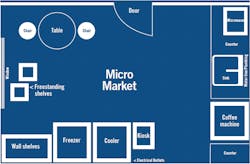Want an increase in same-store revenue? Micro markets might be your answer. Many operators have found success transforming a bank of vending machines into a micro market. And while this new business channel is still in its infancy with much to learn, there is at least one essential aspect – the need for a clean, attractive retail environment.
Micro market retailing
There are many things to consider for a micro market that weren't as necessary for a vending bank. Traffic flow direction, windows, doors, electrical outlets, obstructions (fire alarms, extinguishers, thermostats, etc.) water lines, ice machines, sufficient power, a space in good shape, soffits and location of the data ports are just a few considerations. How much product and what products are to be offered as well as the layout of the space can be greatly restricted or enhanced by the space itself. For example, unless the property is willing to modify or allow modifications to accommodate the need, too few power sockets may prevent the optimal number of coolers or freezers as well as the point-of-sale kiosk and security system. Even the ceiling height can dictate the layout and applicable equipment and décor an operator can use and should be taken into consideration.
One good thing is that there is no maximum or minimum space required. A smaller market might just mean more service trips are needed. The service cycles are a function of the amount of equipment an operator has at that location in addition to minimizing product waste. Big or small, the most important aspect to attracting more consumers is how the market looks. Attractiveness of the market, diversity of choice and constant product merchandising is essential. Well lit, attractive, tightly merchandised markets look full, fresh and inviting.
Market functionality
Depending on the height of the shelving unit and vendor preference, the top 3 to 4 shelves should be slanted, smooth surfaces with side guards and a lip to allow gravity feeding without products falling to the floor. Wire shelving, while less expensive, can restrict the types of products placed on them and limit higher margin product sales. Shelving should be retail quality such as those made with steel for durability.
Depth of a shelf should be at least 14 inches, if not more. The deeper the shelf, the more product can be presented and it will help reduce empty shelf slots. Product availability, ease of stocking and product rotation directly affect the number of restocking trips per location. When investigating shelving options look for added features like allowing for multiple positions, i.e. slanted or horizontal or if the shelving can be pulled out for rapid stocking and reducing of stales.
Freestanding shelves offer versatility
Freestanding shelving, although usually more expensive, can be is more versatile and mobile. Should an operator wish to move the shelving, it is very easy and it does not require fixing anchor holes made with wall-mount units. However, for stability and safety, it is still recommended to secure freestanding units to a wall when possible. An added benefit is that since freestanding shelving typically has a back, the wall behind the shelving is not as visible and typically does not clash with the overall color scheme of the market (if there is one). For wall-mount shelving, the wall is only covered when products are on the shelves and the market is constantly stocked, which may or may not be an issue.
While the primary goal is for the market to have the best look and feel, operators must also balance their investment with the return.How an operator outfits a market with 120 employees with a one-year contract versus that of a 400 employee, multi-year contract location, should be approached very differently. For smaller accounts, while less expensive display options exist, the lower upfront cost needs to be weighed against the overall appearance of the market and, depending on the material and quality of the fixture, the wear and tear that will show over time. In an effort to find the right presentation level, an operator needs to consider the environment, other markets in the area and what was in the location previously. There are so many variables involved in ROI, but it is an important consideration.
Coolers are another area operators should consider carefully. Consider using display trays when presenting food products. Products laying on their side or scattered on the shelf can be less appealing and can cause the loss of sales. Refrigeration needs to breathe. It is imperative to give space on all sides of refrigeration units to maintain the health of the compressors. oolers that lock automatically when the temperature drops below safe levels should be standard for fresh food merchandisers. While not all states currently mandate automatic locking coolers, if there is a cost difference, it is minimal. And they add an excellent element of safety to the market. Should the need arise, units that don't lock can be conveniently interchanged or retrofitted.
Coffee and condiment counters are important in micro markets and the need for microwaves may still exist, so they should also be included in the micro market layout plan.
There are many aspects of unattended micro market retailing/merchandising that have yet to be researched. A good layout with bold product colors, faced properly on freestanding displays are just some basics to start with. Operators need to also consider other implications of a micro market to their operations like how they manage their routes, prepare the products in the warehouse, load the truck and restock locations. Efficiencies gained can contribute to the return on investment.
Better micro market merchandising tips
- Consider the presentation of foods
- Use graphics and signage promoting products and specials - manufacturer provided and otherwise
- Rotate and move inventory to sell it and reduce stales
- Analyze what sells and what does not; an essential practice
- Consult product manufacturers to identify optimal planograms for their products
- Keep the shelves and coolers full; one will sit, two will move
- Merchandise by category/day part
- Your first markdown is your last markdown
- Train drivers/stockers on how to retail product, not just stock it

Emily Refermat | Editor
Emily has been living and breathing the vending industry since 2006 and became Editor in 2012. Usually Emily tries the new salted snack in the vending machine, unless she’s on deadline – then it’s a Snickers.
Feel free to reach Emily via email here or follow her on Twitter @VMW_Refermat.





